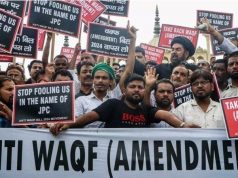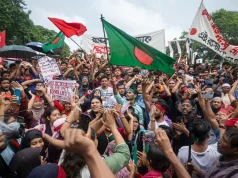Cicero, the great Roman orator, once said, “There is no race so uncivilized, no one in the world . . . so barbarous that his mind has no inkling of a belief in gods . . . .”1 While this statement remains a topic of scholarly debate, it is undeniable that since inception religion has been at the core of human society. In modern democratic states, especially in the West, religion is largely separated from the affairs of the state. However, in India, while it may appear similar, the concept of secularism is different. Indian secularism is not based on the strict separation of religion and state but rather on the principle that no religion should be given preference over another. This distinction is well-expressed by Donald E. Smith, who states: “To most Indians, secular means non-communal, or non-sectarian, but it does not mean non-religious. The basis of a secular state is not a ‘wall of separation’ between state and religion but rather a ‘no preference doctrine,’ which requires that no special privilege be granted to any one religion. The secular state includes the principle that the function of the state must be non-religious.”2 Secularism being an essential part of the Indian State was also important to protect the religious rights of minorities and to ensure that the religious majority may not be preferred over them.
Conviction of Maulana Kaleem and Others
This concept is intriguing but has not yet matured even after seven decades. The provisions of the constitution which deal with freedom of religion come into discussion more often than any other. This time, the issue arose when a special NIA-Anti-Terrorist Squad (ATS) court in Uttar Pradesh sentenced 12 individuals, including the renowned Islamic preacher Maulana Kaleem Siddiqui and Islamic Da’wah Centre founder Mohammed Umar Gautam, to life imprisonment for alleged forced conversions.3 Maulana Kaleem, 67 years old, is known for his religious preaching and initiating inter-faith discourse. After doing a BSc from Meerut, he cleared the Pre-Medical Test (PMT) but instead of pursuing an MBBS, he joined Nadwatul Uloom in Lucknow.4
He has also authored the famous book, “Aap ki amanat apki seva mein” or ‘Returning your Trust’. The book mainly talks about the message of Islam for all human beings so they may know the creation plan of the Lord, the purpose of human beings, and answers to the questions of existence. He has been seen discussing these topics in his public speeches as well. Many Muslim organizations and individuals feel that his work on inter-faith dialogue is the reason behind his persecution along with Maulana Umar Gautam.5 We will analyze the paradox of the scope of propagation as a religious right in theory and shrinking space in practical life but before that it is important to know what religious rights are enshrined in the Constitution.
An Overview of Religious Rights in the Indian Constitution
The third part of the Indian constitution deals with fundamental rights such as the right to life, the right to equality, the right to speech and expression, and so on. Articles 25 to 28 have codified the right to freedom of religion. These rights are not only for individuals but for religious groups as well. It is pertinent to note that Article 25 that is the basis of the right to religious freedom, is not absolute rather it begins with restrictions, “Subject to public order, morality, and health and to the other provisions of this Part, all persons are equally entitled to freedom of conscience and the right freely to profess, practice and propagate religion.”6 Similarly, Article 26 enshrines the right to establish and maintain institutions for religious and charitable purposes and to own, acquire, and administer movable and immovable property, which is also subject to almost the same conditions.7
Essential Religious Practice Test: Narrowing Fundamental Right
Religious freedom was further narrowed down by the Supreme Court when it introduced the Essential Religious Practice Test and started acting as clergy by defining what is essential to the religion and what is not. A religious practice to get protection under fundamental rights needs to pass the rigorous test by proving that such practice is obligatory, is integral to the religion, and has been practiced since time immemorial. If a practice does not pass this three-tier test, it will not get protection under articles 25 and 26. This job of clergy by the Supreme Court is a matter of concern. Professor Faizan Mustafa rightly mentioned “This exercise of determining the essential practice of a religion leads to obscure results and tends to lead the court into an area which . . . is beyond its competence.8
The obscurity of this test was an obvious result that instead of solving queries further made them complex. While dealing with a case of a Muslim police officer who challenged a regulation that prohibited him from growing a beard, the Kerala High Court instead of referring to the Sources of Islamic law, rejected the petition by relying on the irrelevant fact that certain Muslim dignitaries did not have beards.9 Another example of the ERP test resulting in grave error is the Hijab ruling by the Karnataka High Court which upheld the Hijab ban on the ground that the Hijab is not an essential practice in Islam because it does not back any sanction or punishment. If this continues, nothing would remain essential to the religion for the Supreme Court, thus in reality related provisions will become part of the record only.
Right to Propagate and the question of conversion
Beyond the debate of professing and practicing, article 25 also includes the right to propagate religion, and the mere reading definition of the term propagation makes an inference that it is a fundamental right of a person to propagate his religion to others to convince them about the truth of his religion. What follows after one gets convinced is accepting that religion but the Supreme Court does not hold the same view. In the Rev. Stainislaus v. State of Madhya Pradesh, the Supreme Court while deciding on the question of whether the right to propagate includes the right to convert or not, held that clause 1 of the provision does not grant anyone the right to convert another person to one’s own religion but to transmit or spread one’s religion by an exposition of its tenets.10 If the intent of the constituent assembly behind adding the term propagation was only exposition of religion then why does it feel the need to add this in Article 25? when this right was already covered under ‘freedom of speech and expression’. Moreover, reading down this term questions the interpretation of the whole provision in which the right to conscience is also a Fundamental right.
Constituent Assembly’s take on the Right to propagate as a Fundamental Right
The constituent assembly on 6th December 1948, discussed the specific issue of the right to propagate religion as a fundamental right. During this, Mr. Loknath Misra objected to the inclusion of the word propagation as a Fundamental right. According to him, it can only mean paving the way for the complete annihilation of Hindu culture, the Hindu way of life, and manners.11 Interestingly this argument was rebutted by several members including TT Krishnamachari, L Krishnaswami Bharathi, and Lakshmi Kanta Maitra. While arguing Mr. K Santhanam said, “People have freedom of conscience and, if any man is converted voluntarily owing to freedom of conscience, then well and good. No restrictions can be placed against it. But if any attempt is made by one religious community or another to have mass conversions through undue influence either by money or by pressure or by other means, the state has every right to regulate such activity.”12 This debate resulted in the consensus of the majority to include the Right to Propagate as a Fundamental Right. Further, the debate of the constituent assembly clears that conversion as a result of propagation is included in the term. Interpreting it only for exposition is a narrow approach that fails the purpose of its addition.
Anti-conversion laws in India
Forceful conversion by any means is a crime against the whole society and the law needs to take care of such acts. Anti-conversion laws apparently seem to deal with illegal conversions but having a close look would let one know that the act that falls under the ambit of fundamental rights is being criminalized under these special laws. Embracing religion is something very personal and there should not be any space for any allurement, force, or fraud but that does not mean the right to conscience and the right to practice a new religion of one’s choice will be made redundant. Many of the states with such laws demand notice before conversion failing which such act is considered null and void.
The Jharkhand Anti-Conversion law requires the individual converting to notify his or her District Magistrate once the conversion is complete. Failure to comply with these provisions is punishable by a prison term of up to one year, and a fine of up to five thousand rupees.13 Similarly, the Karnataka Protection of Right to Freedom of Religion Act, 2022, requires the District Magistrate, once notified of an individual’s intention to covert, to make a public call for any objections to the conversion. If an objection is lodged, the DM organizes an investigation. If such conversion contravenes the Act, criminal proceedings will be initiated against such person. This procedure questions the basic right of a human being to choose the way of life of one choice. Under these laws conversion without proper notice is declared “illegal and void.”14 At least twelve states in India have legislation criminalizing religious conversions in various circumstances, though enforcement in a few states is stayed.
Conclusion
Although attempts were made to enforce such laws decades ago, in recent times before enacting these laws an intense campaign in the name of ‘Love Jihad’ was propagated to create a narrative against Muslims. Despite the fact check that no such campaign actually ever took place. This was officially verified by the Ministry of Home Affairs in the Lok Sabha by stating that ‘Love Jihad’ is not defined in law and no such case has been reported by any central agencies.15
The narrow approach in interpreting the Fundamental rights related to religious freedom on the one hand and the enactment of laws like ‘Anti conversion’ on the other becomes a dangerous tool that can be used against religious groups, particularly against minorities. Furthermore, after decisions like upholding the Hijab Ban, there is a high need to reconsider the ERP test. Enough scope is available with courts to regulate illegal activities under the restrictions of the provision itself which is “Public order, morality, and health.” Any further restriction would only shrink the space to breathe and would eventually fail the purpose of safeguarding religious freedom under Fundamental rights guaranteed by the constitution.
References
- CICERO, TUSCULAN DISPUTATIONS 37 (J.E. King trans., 1971)
- Donald E. Smith, India as a Secular State 381 (Princeton University Press, New Jersey, 1963).
- https://www.livelaw.in/news-updates/conversion-racket-case-up-court-sentences-umar-gautam-kaleem-siddiqui-life-imprisonment-269404
- https://hamariweb.com/profiles/maulana-kaleem-siddiqui_18308
- https://maktoobmedia.com/india/maulana-kaleem-siddiquis-arrest-decried-as-attack-on-constitutional-right/#google_vignette
- Article 25, The Indian Constitution,1950
- Article 26, The Indian Constitution, 1950
- Faizan Mustafa, Freedom of Religion in India: Contemporary Chalges, CENTRE FOR STUDY OF SOCIETY AND SECULARISM (May 14, 2015)
- Fasi v. Superintendent of Police, 1985 ILLJ Ker 463
- Rev. Stainislaus v. State of Madhya Pradesh, 1977 SCR (2) 611 (India).
- https://caravanmagazine.in/vantage/constituent-assembly-right-to-propagate-religion
- https://caravanmagazine.in/vantage/constituent-assembly-right-to-propagate-religion
- Section 5, Jharkhand Freedom of Religion Act, 2017
- Section 8, THE KARNATAKA PROTECTION OF RIGHT TO FREEDOM OF RELIGION ACT, 2022
- https://www.deccanherald.com/india/no-love-jihad-cases-not-defined-in-law-mha-801441.html






